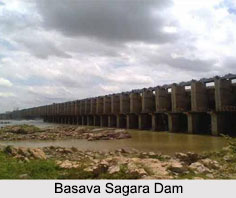 Basava Sagara Dam, formerly known as Narayanpura Dam, is constructed across the Krishna River and located in Siddapur Village of Bijapur District of Karnataka. The dam impounds the Basava Sagar and has a huge storage capacity. The dam was first constructed with the purpose of irrigation but then downstream electrical generation and drinking water considerations enter into its management. The dam is 29 meters high and over 1 km long with 30 gates for water release. It was constructed in the year 1982 and then it provided water for irrigation to 4.21 lakh hectares in Gulbarga District, Yadgir District, Bijapur District and in Raichur District.
Basava Sagara Dam, formerly known as Narayanpura Dam, is constructed across the Krishna River and located in Siddapur Village of Bijapur District of Karnataka. The dam impounds the Basava Sagar and has a huge storage capacity. The dam was first constructed with the purpose of irrigation but then downstream electrical generation and drinking water considerations enter into its management. The dam is 29 meters high and over 1 km long with 30 gates for water release. It was constructed in the year 1982 and then it provided water for irrigation to 4.21 lakh hectares in Gulbarga District, Yadgir District, Bijapur District and in Raichur District.
Structure of Basava Sagara Dam
The dam has 30 spillway gates into it, each of which is made out of the Ogee type. This common and basic design transfers excess water from behind the dam down a smooth incline into the river flow. The spillway gates are lined on the bottom and sides with concrete to protect the dam. The dam has been classified in the earthen and masonry builds type.
Visiting Information to Basava Sagara Dam
Kolhapur Airport and Bijapur Railway Station are nearest to reach the dam. National Highway 50 connects Bijapur District to other major cities of India.
This article is a stub. You can enrich by adding more information to it. Send your Write Up to content@indianetzone.com.















